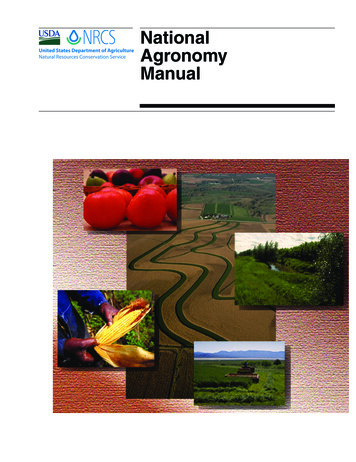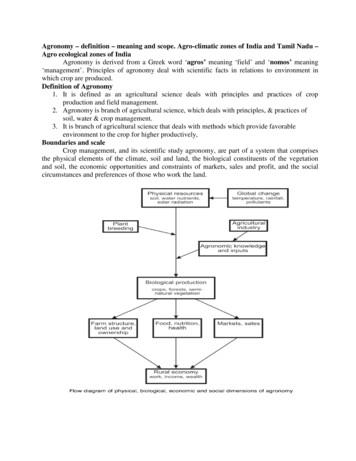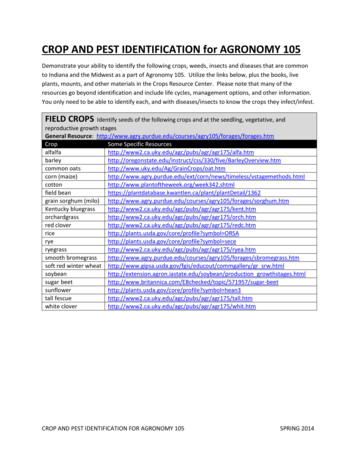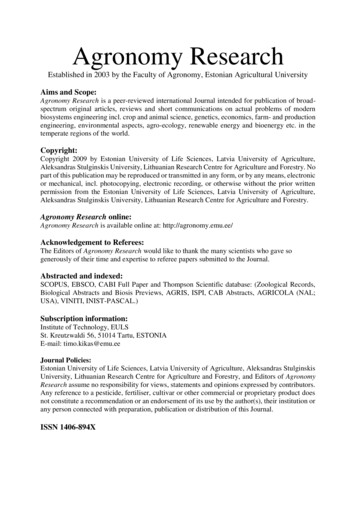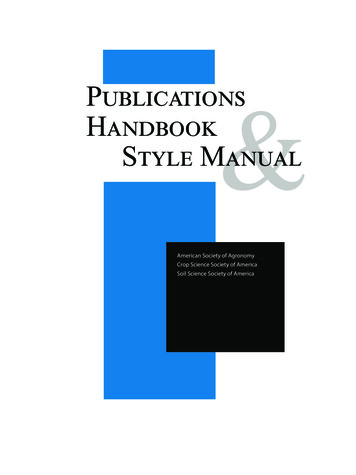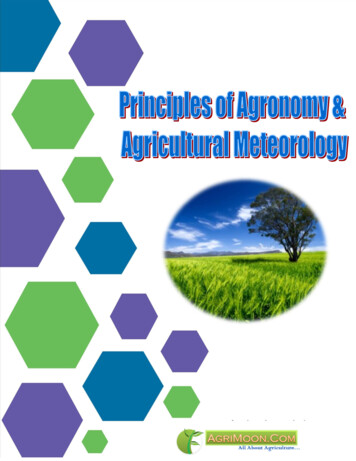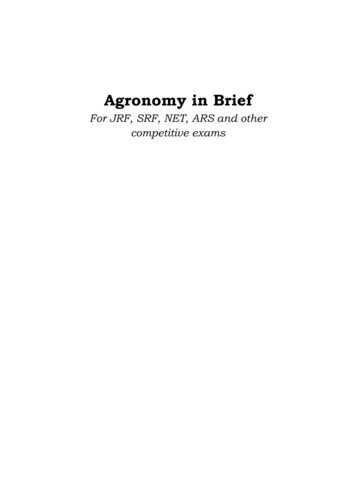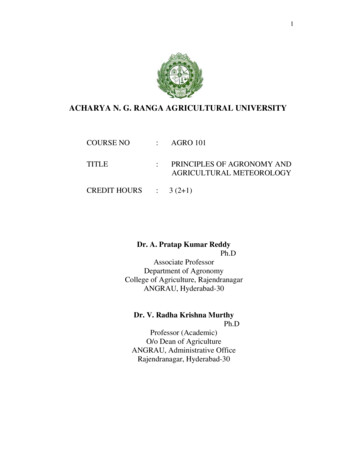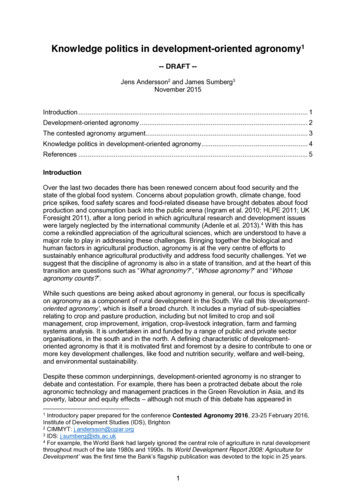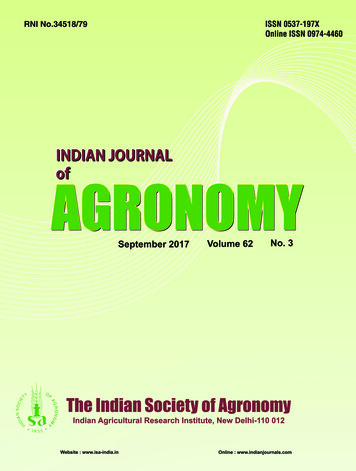
Transcription
INDIAN SOCIETY OF AGRONOMY(Founded in 1955)Executive Council for 2017 and 2018President: Dr A.K. Vyas, ADG (HRM), ICAR, KAB-II, New DelhiVice President: Dr V.K. Singh, Head, Division of Agronomy, ICAR-IARI, New DelhiSecretary: Dr Y.S. Shivay, Professor & Principal Scientist, Division of Agronomy, ICAR-IARI, New DelhiJoint Secretary: Dr Prashant S. Bodake, Professor (Agronomy), MPKV Campus, Nasik, MaharashtraTreasurer: Dr Ashok Kumar, Principal Scientist, ICAR, KAB-I, New DelhiEditor-in-Chief: Dr T.C. Jain, Ex-Senior Agriculturist, World Bank, Gurugram, HaryanaPast Presidents: Drs Ambika Singh, P.S. Lamba, G.B. Singh, A.S. Faroda, Panjab Singh, D.P. Singh,M.S. Gill, Arvind Kumar and Gurbachan Singh[Deceased: Sh. Panjabrao S. Deshmukh, Drs P.C. Raheja, O.P. Gautam, Maharaj Singh,R.P. Singh, R.P.S. Ahlawat]CouncillorsAndhra PradeshDr V. Chandrika, TirupatiPunjabDr Thakar Singh, LudhianaAsomDr Hemen Kalita, NagaonRajasthanDr Dilip Singh, UdaipurBiharDr Ravi Nandan, SamastipurTamil NaduDr A. Velayutham, KillikulamChhattisgarhDr Rajendra Lakpale, RaipurTelanganaDr K. Avil Kumar, HyderabadDelhiDr Shankar Lal Jat, New DelhiUttarakhandDr Rohitashav Singh, PantnagarGujaratDr Arvindbhai M. Patel, SK NagarUttar PradeshDr Satish Kumar Tomar, SohnaHaryanaDr Satish Kumar, HisarWest BengalDr Arun Kumar Barik, SriniketanHimachal PradeshDr Janardan Singh, PalampurIndustriesDr D.S. Yadav, FAI, New DelhiJammu & KashmirDr B.C. Sharma, JammuDr Jitendra Kumar, Syngenta, RudrapurJharkhandDr M.S. Yadav, RanchiDr O.P. Singh, Dhanuka, New DelhiKarnatakaDr V.S. Kubsad, DharwadDr Rajvir Rathi, Bayer, GurugramKeralaDr A. Abdul Haris, KayamkulamDr R.M. Kummur, NABARD, MumbaiMadhya PradeshDr M.D. Vyas, SehoreDr Shashi Kant Bhinde, MOSAIC, GurugramMaharashtraDr V.S. Khawale, NagpurDr Soumitra Das, IZA, New DelhiN.E.H. StatesDr Subhash Babu, UmiamOdishaDr L.M. Garnayak, BhubaneswarMandate of the Society1.To disseminate knowledge of Agronomy2.To encourage research in the field of soil, water and crop management3.To provide suitable forum for exchange of ideas to research workers
EDITORIAL BOARD (2017 and 2018)Editor-in-Chief : Dr T.C. Jain, Ex-Senior Agriculturist, World Bank, Gurugram, Haryana, IndiaCo-Editor-in-Chief : Dr D.S. Rana, ICAR-Emeritus Scientist (Agronomy), IARI, New Delhi, IndiaEditorsDr A. Pratap Kumar Reddy, Tirupati, Andhra PradeshDr A. Arunachalam, New DelhiDr K.R. Reddy, Mississippi, USADr K.R. Sheela, Thiruvananthapuram, KeralaDr Amit Kar, New DelhiDr Anil Dixit, Raipur, ChhattisgarhDr Kajal Sengupta, Nadia, West BengalDr Kaushik Majumdar, IPNI, Asia & Africa, GurugramDr Ashok Kumar Gupta, Jobner, RajasthanDr Ashok Kumar, Hisar, HaryanaDr M.A. Shankar, Bengaluru, KarnatakaDr M.B. Dhonde, Ahmednagar, MaharashtraDr B. Gangaiah, Port Blair, Andaman & NicobarDr B. Gangwar, Meerut, Uttar PradeshDr M.K. Arvadia, Navsari, GujaratDr M.P. Sahu, Bikaner, RajasthanDr B.K. Sagarka, Junagadh, GujaratDr B.P. Singh, Agra, Uttar PradeshDr M.V. Venugopalan, Nagpur, MaharashtraDr M.V.K. Sivakumar, Geneva, SwitzerlandDr B.S. Dwivedi, New DelhiDr Basudev Behera, Bhubaneswar, OdishaDr Masood Ali, Kanpur, Uttar PradeshDr Navin Kumar Jain, New DelhiDr Bhagirath Chauhan, ACIAR, AustraliaDr Biswajit Guha, Shillongani, AsomDr O.P. Chautervedi, Jhansi, Uttar PradeshDr P. Devasenapathy, Coimbatore, Tamil NaduDr C. George Thomas, Trichur, KeralaDr C.M. Singh, Gorakhpur, Uttar PradeshDr P.G. Ingole, Akola, MaharashtraDr R.K. Paikray, Bhubaneswar, OdishaDr Chhibubhai L. Patel, Navsari, GujaratDr D.K. Sharma, Lucknow, Uttar PradeshDr R.P. Sharma, Bhagalpur, BiharDr R.S. Sharma, Jabalpur, Madhya PradeshDr D.M. Hegde, Bengaluru, KarnatakaDr D.N. Gokhale, Parbhani, MaharashtraDr Raihana Habib Kanth, Kashmir, Jammu & KashmirDr Rambilash Mallick, Kolkata, West BengalDr D.S. Yadav, Budaun, Uttar PradeshDr Dileep Kachroo, Chatha, Jammu & KashmirDr Rattan Lal, Ohio, Columbus, USADr S.A. Chavan, Dapoli, MaharashtraDr G. Pratibha, Hyderabad, TelanganaDr G. Ravindra Chary, Hyderabad, TelanganaDr S.K. Dhyani, New DelhiDr S. Panneerselvam, Coimbatore, Tamil NaduDr Girish Jha, Jabalpur, Madhya PradeshDr Guriqbal Singh, Ludhiana, PunjabDr S.P. Singh, Varanasi, Uttar PradeshDr S.S. Tomar, Kota, RajasthanDr H.L. Sharma, Palampur, Himachal PradeshDr Ishwar Singh, Jodhpur, RajasthanDr Shanti Kumar Sharma, Udaipur, RajasthanDr Sandip Kumar Pal, Ranchi, JharkhandDr J.C. Dagar, Karnal, HaryanaDr J.K. Bisht, Almora, UttarakhandDr Seema Jaggi, New DelhiDr Sohan Singh Walia, Ludhiana, PunjabDr J.P. Dixit, Gwalior, Madhya PradeshDr J.S. Mishra, Patna, BiharDr T.K. Das, New DelhiDr V.C. Patil, Dharwad, KarnatakaDr Jagdev Singh, Hisar, HaryanaDr Jayant Deka, Jorhat, AsomDr V.S. Korikanthimath, Dharwad, KarnatakaDr V.S. Pawar, Nasik, MaharashtraDr K. Annapurna, New DelhiDr K. Velayudham, Madurai, Tamil NaduDr Vikrant Singh, Haridwar, UttarakhandDr C. Vishwanathan, New DelhiDr K.G. Mandal, Bhubaneswar, Odisha
INDIAN JOURNAL OF AGRONOMYIndian Journal of Agronomy, the official journal of the Indian Society of Agronomy, is published quarterly inthe month of March, June, September and December since 1956. The journal publishes papers based on theresults of original research in following areas:i.Crop production and managementii.Soil-water-plant relationshipiii.Cropping and farming system researchiv.Agro-ecosystems and environment managementv.Other areas of agronomy research andvi.Invited review papersIndian Journal of Agronomy is indexed in the AGRIS, published by the FAO, theScience Citation Index (SCI) and Current Contents (Agriculture, Biology andEnvironmental Sciences) published by the Institute of Scientific Information (ISI),Philadelphia. It is also indexed in the abstraction journals of the Centre forAgriculture and Biosciences International (CABI) as well as all the majorabstracting services of the world.Membership and Journal SubscriptionExisting (2016)AnnualLife800 (400*)8,000800 (400*)8,000100 (75*)1,000100 (75*)1,000PrintOnlinePrint 500450650A. Individual MembershipIndian ( )Foreign (US or its equivalent)*For StudentsB. Libraries and Institutions(Annually)Indian ( )Foreign (US or its equivalent)*Approved New Subscription(2017)AnnualLifeOnline Print OnlinePayment should be made by Demand Draft in favour of INDIAN SOCIETY OF AGRONOMY payable at NewDelhi. Back Volumes of the journal, symposia proceedings and books are available for sale.All Correspondence may please be addressed to Secretary, Indian Society of Agronomy, Division of Agronomy,ICAR-Indian Agricultural Research Institute, New Delhi 110 012. Telefax: 0091-11-25842283; 09717078548;E-mail: secretary isa@hotmail.com; Visit Society Website: www.isa-india.in for author guidelines and other information.
EditorialFrom the Desk of the EditorsDear Esteemed ISA Members,After the New Editorial Board, we have published two Editorials. As you are aware that our overall effortis to improve the “Quality and Relevance of Agronomic Research” which should be reflected in our ISA Journal.Since this is a joint effort, we would like to request all the ISA members and especially to the Editors tocommunicate their views on the published Editorials and also suggest the areas where we need to improve andhow?In this issue, we would like to share with you the most important Prime Minister’s commitment to doublethe income of the farmers by 2022. Three important ways to increase the farmer’s income are: 1) to reduce thecost of cultivation and 2) to increase the productivity and assured high price and 3) facilitate earning extraincome through additional activities such as mixed farming, post-harvest, value addition, processing and marketing. Except the price increase, we Agronomists can contribute a lot on this important National issue. Wetherefore suggest that in our research publications we can focus a little bit more on the Economic analysis ofour investigations. Reducing the price of inputs and assured reasonable prices of the produce are not in ourhands but we can no more ignore it, as without addressing this issue we can never achieve the PM’s Commitment. To address this issue, can we form a small committee which can interact with the Government authoritiesand suggest some practical and feasible ways to address this most difficult but most important issue completelyneglected so far. We can even include the reputed Scientists/Economists from other disciplines in the proposedGroup. An attempt to publish the ‘Success Stories of Agronomy’ is another right move in this direction fromISA.The Society is striving to find out the ways to improve the job opportunities for Agronomists. We have tokeep in mind the fundamental principle that “Jobs are not created looking to available resource personnel, butwe have to change ourselves to be competent and suit to the available opportunities”.We are also looking to the disparity with regard to publication of research papers in Indian Journal ofAgronomy with respect to the crops, region and ICAR institutes and SAUs. Dr. A K Vyas, President of ISA withthe help of his colleagues has done an extensive analysis of papers published in ISA Journal during 2013 to 2016(Four years). We are happy to report that the publications for crops were almost as per importance of crops andcropping systems in the country with 18% publication on rice-wheat based cropping system and additional 7%on rice and 10% on wheat–based cropping system (other than rice-wheat). The only suggestion that we canmake is to give little more emphasis on diversification with high value crops (wherever possible) to improve thefarmers income. The publications from SAUs and ICAR Institutes are 32% and 67% respectively, almostcorresponding to the Agronomists working in the system. Within ICAR Institutes, IARI alone has more than50% publications, which can be attributed to more than 15 PG students admitted every year who contribute toa larger part of IARI publications. Kerala is one state from where the contribution is less than 1%. Similarly theInternational publications are also less than 1% and we need to encourage this.T.C. JainEditor-in-ChiefD.S. RanaCo-Editor-in-Chief
INDIAN JOURNAL OF AGRONOMYSeptember 2017 Volume 62 No. 3CONTENTSResearch PapersK.N. MISHRA, A.K. PATRA, L.M. GARNAYAK, A.K. MOHANTY AND S.K. SWAIN. Long-term effects of integratednutrient management on productivity and soil properties of rice (Oryza sativa)–rice cropping system incoastal Odisha239SANAT KUMAR DWIBEDI, GOPAL CHANDRA DE AND SUDHI RANJAN DHUA. Relative performance of rice (Oryzasativa)–ratoon production system as influenced by date of sowing and system of cultivation of plantrice genotypes247DINESH KUMAR SINGH, ROHITASHAV SINGH, GAURAV DEEP SINGH, AJIT PRATAP SINGH, SUMIT CHATURVEDI, JODHPAL SINGH, AMARJEET RATHI AND MOHAN SINGH. Diversification of rice (Oryza sativa)–wheat (Triticumaestivum) system and its influence on productivity, profitability and energetics under on-farm situation255MADANE ANANDA JAGANNATH, J.K. SINGH, AVIJIT SEN AND J.S. BOHRA. Effect of irrigation and nitrogen management on rice (Oryza sativa) under system of rice intensification and its residual effect on lentil(Lens culinaris)260A.K. PATRA, K.N. MISHRA, L.M. GARNAYAK AND A.K. MOHANTY. Influence of long-term organic nutrientmanagement on soil quality and crop productivity in rice (Oryza sativa)–potato (Solanum tuberosum)–okra (Abelmoschus esculentus) cropping system under irrigated condition268RAMESHWAR KUMAR, J.P. SAINI, S.K. SHARMA AND MEENAKSHI SETH. Influence of cereal–legume combinationand sources of nutrients on productivity and profitability under organic production system275D.P. PACHARNE. Production potential and energy dynamics of efficient cropping systems under diversenutrient management practices280S.K. CHAUHAN AND S.K. SINGH. Effect of alkali and canal waters in cyclic and blended mode on potato(Solanum tuberosum)–sunflower (Helianthus annuus)–sesbania (Sesbania sesban) cropping sequence287V.G. MORE, M.B. DHONDE, S.B. GADGE, B.D. BHAKARE AND J.B. SHINDE. Performance of summer chilli(Capsicum annum)–watermelon (Citrullus lanatus) crop sequence under different irrigation regimesand fertigation levels under silver black polyethylene mulch295A.A. SHAHANE, Y.S. SHIVAY, D. KUMAR AND RADHA PRASANNA. Contribution of microbial inoculation andzinc-fertilization to growth and yield of rice (Oryza sativa) under different cultivation methods in a subtropical and semi-arid type climate301SANTOSH KUMAR, RAKESH KUMAR, J.S. MISHRA, S.K. DWIVEDI, VED PRAKASH, N. BHAKTA, A.K. SINGH, S.K.SINGH, S.S. SINGH, A.A. HARIS, K.K. RAO, S. MONDAL, B.P. BHATT, SUDHANSHU SINGH AND ASHOK YADAV.Evaluation of rice (Oryza sativa) cultivars under different crop establishment methods to enhanceproductivity, profitability and energetics of rice in middle Indo-Gangetic Plains of India307S. MOHAPATRA, A.K. MOHANTY, S.K. TRIPATHY, B.R. NAYAK, N. PANIGRAHY, P.K. SAMANT AND S. LENKA. Effectof irrigation and methods of weed management on weed dynamics and yield of summer rice (Oryzasativa) under system of rice intensification315(Continued)
IICONTENTS[Vol. 62, No. 3I.A. SHAH, B.C. SHARMA, BRIJ NANDAN, RAKESH KUMAR, AKHIL VERMA AND MONIKA BANOTRA. Residual effectsof different soil organic amendments applied to aerobically grown rice (Oryza sativa) on succeedingwheat (Triticum aestivum) under basmati rice–wheat cropping system321HARGILAS, A.K. SINGH, S.L. JAT, P.K. ROKADIA AND ARVID KUMAR. Response of maize (Zea mays) hybridsto nutrient management practices for enhancing productivity and profitability under sub-humid condition of Southern Rajasthan326TIRYAK KUMAR SAMANT AND TUSHAR RANJAN MOHANTY. Effect of sowing date and weed management onproductivity and economics of rainfed mungbean (Vigna radiata)332V.V. SAGVEKAR, B.D. WAGHMODE AND A.S. KAMBLE. Effect of nitrogen and phosphorus management onproductivity and profitability of groundnut (Arachis hypogaea)338HARPREET KAUR VIRK, GURIQBAL SINGH AND POONAM SHARMA. Productivity, nutrient uptake, energy indicesand profitability of soybean (Glycine max) as influenced by planting methods, Bradyrhizobium andplant growth promoting rhizobacteria341BONTI GOGOI AND JAYANTA DEKA. Integrated weed management in chilli (Capsicum annuum) grown afterrice (Oryza sativa) under rice–fallow system348SHATRUGHNA KUMAR SINGH, UMESH SINGH, DILEEP KUMAR MAURYA, ADITYA PRAKASH DWIVEDI AND JAI DEV. Integrated weed management practices in turmeric (Curcuma longa)354Research CommunicationsY.K. ZIAR, T.K. DAS, A.R. HAKIMI, KAPILA SHEKHAWAT AND A.K. PAUL. Chemical weed management inwheat (Triticum aestivum) under semi-arid conditions of Kandahar, Afghanistan359SHANTI DEVI BAMBORIYA, R.S. BANA, V. POONIYA, K.S. RANA AND Y.V. SINGH. Planting density and nitrogenmanagement effects on productivity, quality and water-use efficiency of rainfed pearlmillet (Pennisetumglaucum) under conservation agriculture363QUDRATULLAH EHSAN, D.S. RANA AND ANIL K. CHOUDHARY. Productivity and resource-use efficiency ofgreengram (Vigna radiata) as influenced by sowing methods and phosphorus levels under semi-aridconditions of Afghanistan367AASTHA AND JANARDAN SINGH. Productivity, profitability and quality of soybean (Glycine max) as influenced by sowing date and row spacing under mid-hill conditions of Himachal Pradesh371HARIDARSHAN CHOUKSEY, VIRENDER SARDANA AND PUSHP SHARMA. Variability in Indian mustard (Brassicajuncea) genotypes in response to applied phosphorus374AMIT KUMAR, B.S. MAHAPATRA, V.P. SINGH, ANIL SHUKLA, M.S. NEGI, AJIT YADAV, SAMAR PAL SINGH, GAURENDRAGUPTA AND MOHAN SINGH. Effect of nutrient levels on yield, nutrient uptake and economics of Indianmustard (Brassica juncea) in tarai region of Uttarakhand378POOJA GUPTA SONI, RAJENDER KUMAR YADAV, GAJENDER YADAV AND TARAMANI YADAV. Utilization of high residual sodium carbonate water neutralized with chemical amendments for fodder sorghum (Sorghumbicolor) production382
Indian Journal of Agronomy 62 (3): 239 246 (September 2017)Research PaperLong-term effects of integrated nutrient management on productivity and soilproperties of rice (Oryza sativa)–rice cropping system in coastal OdishaK.N. MISHRA1, A.K. PATRA2, L.M. GARNAYAK3, A.K. MOHANTY4 AND S.K. SWAIN5All India Coordinated Research Project on Integrated Farming Systems, Orissa University of Agriculture andTechnology, Bhubaneswar, Odisha 751 003Received : March 2016; Revised accepted : June 2017ABSTRACTA long-term experiment was initiated in 1983–84 and continued for 31 years on integrated nutrient management (INM) in rice (Oryza sativa L.)–rice cropping system at Bhubaneswar, Odisha. The study was conducted onsandy loams under irrigated conditions in a permanently laid out plot in randomized block design with 12 treatments and 4 replications. Application of 50% recommended dose of chemical fertilizers (RDF) coupled with 50%recommended N through green manuring of azolla or through FYM to rainy season (kharif) rice followed by supplyof 100% RDF through chemical fertilizers to summer rice resulted in higher system yield of 9.07 and 8.75 t/ha/yearrespectively. This INM treatment was also most sustainable and improved the physico-chemical properties of thesoil with respect to bulk density, soil organic carbon, available NPK, microbial biomass carbon and soil nutrientbalance. Reduction in RDF by 100, 50 and 25% without supplementing any organic manure reduced system yieldby about 52, 23 and 10%, respectively compared to RDF. Reduction in yield due to supplementation of 25 and50% N through organic sources was to the tune of 10% during initial five years, and the yield gap between RDFand INM practices narrowed down with passage of time. Yield advantage due to supplementation of N throughgreen manuring was noticed after 10 years, whereas that of FYM after 15 years. On the other hand, no yield advantage was observed with supplementation of 25% N through paddy straw even after 31 years. Application of50% RDF through fertilizers along with 50% recommended N through green manuring of azolla to rainy season(kharif) rice followed by supply of RDF through fertilizers to summer rice recorded the highest system gross returns 1,11,870 and net returns 65,644 with the highest benefit: cost ratio 2.42.Key words : Integrated nutrient management, Long-term experiment, Nutrient balance, Physico-chemical-microbial properties of soil, Rice–rice cropping system, System yieldRice–rice is the major cropping system in the irrigatedareas of Odisha. But productivity of rice in Odisha is oneof the lowest in the country, mostly because of inadequateand imbalanced supply of plant nutrients. Fertilizer consumption of the state is as low as 58.7 kg/ha. Poor economic condition of the rice farmers of the state is one ofthe major causes of low dose of fertilizers. With regard torice cultivation, farmers of coastal areas were applyingonly 20 kgN/ha without any P or K, however, applicationof 2 t FYM/ha was a common practice with the farmers.Since rice is the staple food crop of the state, it is necessary to increase the productivity of rice–rice system tomeet the food requirement of the burgeoning population.2Corresponding author’s Email: alokpatra2000@yahoo.co.inSenior Scientist (Soil Sciences), 2,5Senior Scientist (Agronomy),3Dean, College of Agriculture, OUAT, Bhubaneswar, 4Principal Scientist (Agronomy)1Not only the productivity has to be increased but it shouldbe sustainable also over the years. The recommended doseof NPK fertilizers alone does not sustain soil productivityunder continuous intensive cropping (Yaduvanshi andSharma, 2010), whereas inclusion of organic manuresimproves physical properties, the biological status of soil,soil fertility and crop yields (Yaduvanshi et al., 2013).Thus, increasing the productivity and sustainability ofrice–rice system through judicious combination of organicand inorganic sources of plant nutrients is important toeconomise on fertilizer use, besides maintaining productivity and soil health in the long run. A permanent plotexperiment on ‘integrated nutrient supply system in rice–rice crop sequence’ in Odisha was started in 1983-84 under the All India Coordinated Research Project on Integrated Farming Systems at Central Research Station ofOrissa University of Agriculture and Technology,Bhubaneswar.
MISHRA ET AL.240MATERIALS AND METHODSA long-term (31-years) field experiment was conductedfrom 1983–84 to 2013–14 at Central Research Station,Orissa University of Agriculture and Technology,Bhubaneswar (20 26' N, 85 81' E, 34 m above mean sealevel) under irrigated conditions. The soil at the study siteis a sandy loam (sand 68%, silt 15% and clay 17%) andbelongs to Typic Epiaquepts having pH 5.34, bulk density1.50 Mg/m3, organic carbon 0.43%, available N, P and Kof 254.2, 20.3 and 210.4 kg/ha respectively. The climate ishot and humid with an average annual rainfall of 1482mm, received mostly in the monsoon months from July toSeptember. The mean maximum and minimum temperature were 31.5 and 22.3 C respectively. The experimentwas conducted in a permanently laid out plot in randomized block design with 12 treatments and 4 replicationsand the details are given in Table 1.The organic sources of nutrients used in the experimentsuch as farm yard manure (FYM), paddy straw and azollawere analysed for nitrogen content and their quantities,required to substitute a specified amount of N (50 and25%) as per the treatments were calculated. The nutrientcontents of the organic manures on air dry weight basiswere 0.56% N, 0.28% P and 0.64% K of FYM, 0.45% N,0.13% P and 1.66% K of paddy straw and 3.56% N,0.65% P and 1.88% K of azolla. Inorganic N, P and Kwere given through urea, single super phosphate and muriate of potash. Soil samples were drawn at initial and at theend of each cropping cycle (up to 31st cropping cycle)from a depth of 0–15 cm from each treatment and soil organic carbon (SOC), N, P and K content were analysedusing standard procedures (Jackson, 1973). A portion offresh soil samples were passed through a 2 mm sieve andstored at 4 C for determination of microbial population(Clark, 1965) and soil microbial biomass carbon (MBC)(Anderson and Domsch, 1978). The MBC was estimatedfrom the equation, MBC 2.64 Ec, where Ec is the difference between organic carbon extracted from the K2SO4extract of fumigated and non-fumigated soils.In case of organic nutrient management, all manureswere applied before final land preparation and thoroughlyincorporated in the soil. In case of inorganic nutrient management, full quantity of P and K were applied as basaland N was applied in split doses, 25% as basal, 50% attillering and rest 25% at panicle initiation stage. The plotsize was 10 m 5 m. The test varieties were ‘Savitri’,‘Swarna’ and ‘Pratikshya’ for rainy season (kharif), and‘Lalat’, ‘Konark’ and ‘Naveen’ for summer. Standard agronomic management practices were followed to raise thecrop.Grain and straw yields of rice were recorded in eachseason and system yields were calculated for each cycle.[Vol. 62, No. 3System yield trends were analysed on 5-yearly averagebasis (1983–88, 1988–93, 1993-98, 1998-03, 2003-08)except for 2008-14 which was on 6-yearly average basis.Average yield for each treatment was also calculated over31 system cycles at the end of experimentation. The treatment with recommended dose of inorganic nutrients wastaken as reference treatment and increase or decrease insystem yield was calculated for each treatment on 5-yearlyaverage basis over this treatment for comparison. For economic analysis (cost of cultivation and net returns) costs ofinputs and prices of output were used from 2013–14 for allthe years. Statistical analyses were done using standardmethodology of randomized block design.RESULTS AND DISCUSSIONGrain and straw yieldsAveraged over 31-years, application of 50% recommended dose of fertilizers (RDF) coupled with 50% recommended N (RN) through green manuring of azolla torainy season (kharif) rice followed by supply of RDFthrough chemical fertilizers to summer rice resulted inhigher system yield (Table 1). These grain yields wereabout 125% higher over no fertilizer control. This treatment combination increased average system yield by 7 and42% over application of RDF and farmers’ practice respectively. Application of 50% RDF through fertilizerscoupled with 50% RN through FYM to kharif rice followed by supply of RDF through chemical fertilizers tosummer rice was the second best treatment combination.Banerjee and Pal (2009) also observed higher system productivity in rice–rice system by reducing 50% RDF andsupplementing 50% recommended N through green manuring to kharif rice followed by RDF through chemicalfertilizers to summer rice in new alluvial soils of WestBengal in a long-term fertility experiment. Long-term application of organic matter might have improved thephysico-chemical properties of soil that resulted in increased productivity by increasing availability of plantnutrients (Chaudhary and Thakur, 2007). Further, organicmatter also maintained regular supply of macro and micronutrients in soil resulting in higher yields (Sharma andSubehia, 2014).Application of 50% RDF through fertilizers coupledwith 50% recommended N through green manuring orFYM to kharif rice followed by supply of RDF throughfertilizers to summer rice also recorded significantlyhigher system straw yield compared to supply of RDFthrough fertilizers to both the crops (Table 1). However,supplementation of paddy straw as organic manure had nosignificant beneficial effect on 31-years average systemgrain or straw yields. Application of 50% RDF coupledwith 50% recommended N through paddy straw to kharif
7.437.135.640.160.46100% RDF throughfertilizers75% RDF throughfertilizersFarmers’ 2.217.340.240.718.920.381.1110.09 12.9510.26 13.519.429.809.6710.17 965.654.454.657.258.560.849.851.310.337.7CoC NMR( 103 ( 01.261.91Benefit:costratioRDF, recommended dose of fertilizers; RDN, rcommended dose of nitrogen; FYM, farm yard manure; CoC, cost of cultivation; NMR, net monetary returns; RDF (N–P–K kg/ha): 80–17.5–33; Farmers’ practice: N–P–K @ 20–0–0 kg/ha 2 t FYM/ha to both kharif and summer crops; *Mean of 6 years data; mean of 31 years data; Sale Price ( /t): rice grain, 11,000; rice straw,10006.739.547.3875% RDFthrough fertilizers10.187.466.869.036.45100% RDF No manure andfertilizers (control)50% RDFthrough fertilizers100% RDF throughfertilizers75% RDF throughfertilizers100% RDF throughfertilizers100% RDF throughfertilizersNo manure andfertilizers (control)50% RDF throughfertilizers50% RDF throughfertilizers75% RDF throughfertilizers100% RDF throughfertilizers50% RDF throughfertilizers 50%RDN through FYM75% RDF throughfertilizers 25%RDN through FYM50% RDF throughfertilizers 50%RDN throughpaddy straw75% RDF throughfertilizers 25%RDN throughpaddy straw50% RDF throughfertilizers 50%RDN as greenmanuring of Azolla75% RDF throughfertilizers 25%RDN as greenmanuring of AzollaFarmers’ practiceSEm CD (P 0.05)MeanMeanMeanMeanMeanMean*Mean 1983–84 to1988–89 to1993–94 to1998–99 to2003–04 to2008–09 to1983–84 3–142013–14Grain Straw Grain Straw Grain Straw Grain Straw Grain Straw Grain Straw Grain Straw75% RDF throughfertilizersRabiKharifTreatmentTable 1. Effect of integrated nutrient management on system grain and straw yields (t/ha) and economics of rice–rice cropping system over yearsSeptember 2017]EFFECT OF INM OF RICE–RICE CROPPING SYSTEM241
242MISHRA ET AL.rice followed by supply of RDF through chemical fertilizers to summer rice reduced average system grain yieldmarginally compared to application of RDF to both seasoncrops, though the reduction was not significant. This wasin conformity with the findings of Singh et al. (2006) inrice–wheat cropping system.Reduction in RDF without supplementing any organicmanure significantly reduced the system grain and strawyields compared to application of RDF (Table1). Application of 50% RDF to both kharif and summer crops throughfertilizers, 50% RDF to kharif and RDF to summer cropand 75% RDF to both kharif and summer crops reducedaverage system yield by 25, 10 and 12% compared toRDF. Similar results were also reported in rice–wheatcropping system by Upadhyay and Vishwakarma (2014).Yield trend analysisGrain yield trend analysis of data averaged over fiveyears indicates that application of sub-optimal doses ofchemical fertilizers reduced system yield throughout the31-years of experimentation compared to supply of RDF.Reduction in yield due to supplementation of 25 and 50%N through organic sources was to the tune of 10% duringinitial five years, and the yield gap between RDF and integrated nutrient management practices narrowed downwith passage of time. Yield advantage due to supplementation of N through green manuring was noticed from 10thyear onwards, whereas that of FYM after 15 years.The treatments with organic supplementation weremore sustainable than those supplied with sub-optimaldose of inorganic fertilizers alone. Organic manure aloneor
INDIAN SOCIETY OF AGRONOMY (Founded in 1955) Executive Council for 2017 and 2018 President : Dr A.K. Vyas, ADG (HRM), ICAR, KAB-II, New Delhi Vice President : Dr V.K. Singh, Head, Division of Agronomy, ICAR-IARI, New Delhi Secretary : Dr Y.S. Shivay, Professor & Principal Scientist, Division of Agronomy
